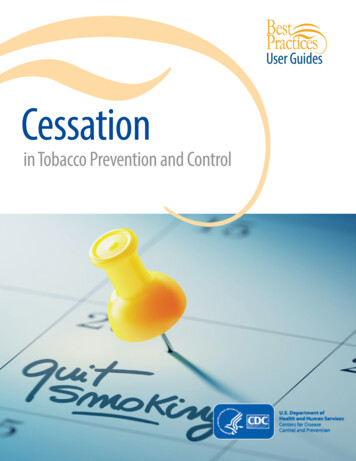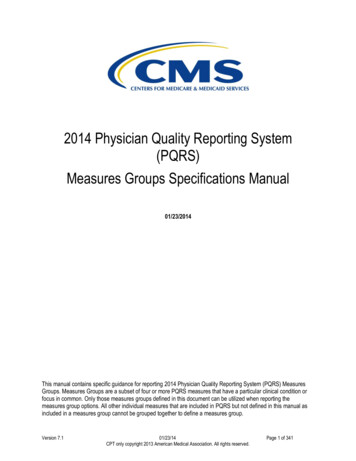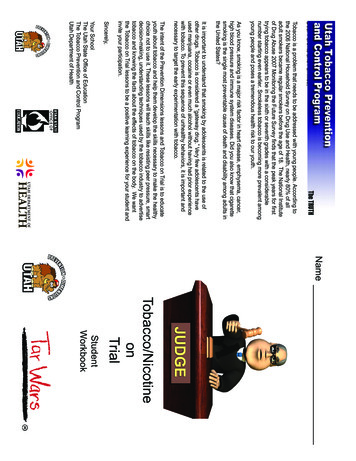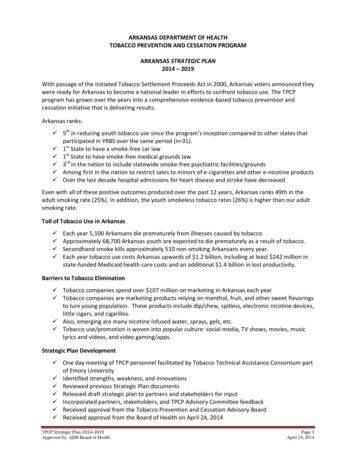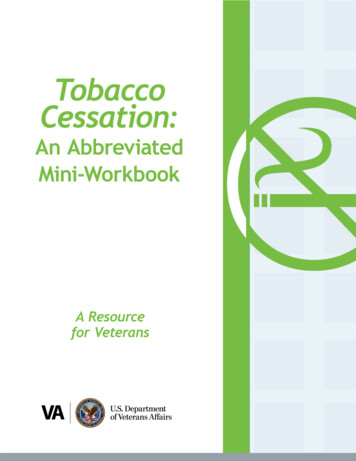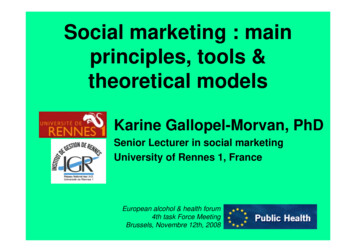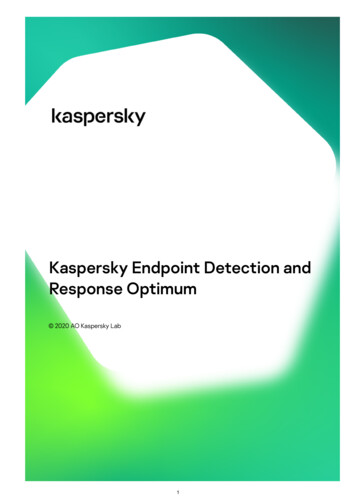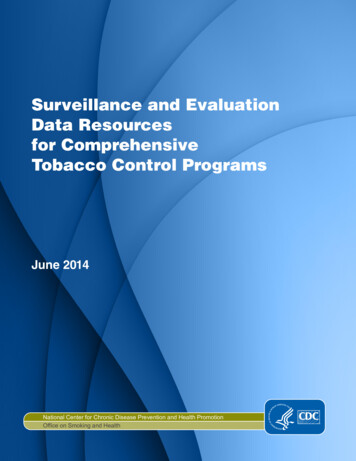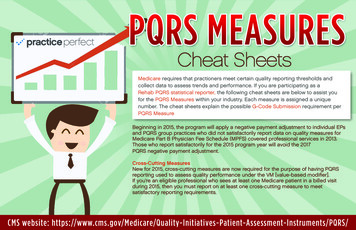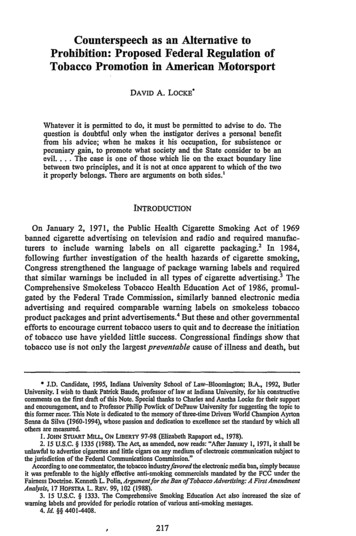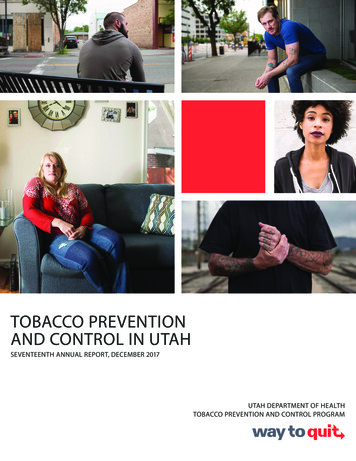
Transcription
TOBACCO PREVENTIONAND CONTROL IN UTAHSEVENTEENTH ANNUAL REPORT, DECEMBER 2017UTAH DEPARTMENT OF HEALTHTOBACCO PREVENTION AND CONTROL PROGRAM
Utah Department of HealthTobacco Prevention and Control Program(877) To view this report online, visitwww.tobaccofreeutah.org/pdfs/
TABLE OF CONTENTSTobacco Prevention and Control in UtahHelping Tobacco Users Quit . 5Anti-tobacco Advertising . 7Preventing Youth Tobacco Use. 10Eliminating Exposure to Secondhand Smoke / Cigarette Consumption. 11Ending Tobacco-related Disparities. 12Electronic Cigarettes and Vape Products. 13TPCP Funding, FY2017. 14Small Areas and Local Health DistrictsSmoking Rates by Local Health District and Utah Small Area. 15Vape Product and Chewing Tobacco Use by Local Health District. 16Bear River Health Department.17Central Utah Public Health Department.18Davis County Health Department.19Salt Lake County Health Department.20San Juan Public Health Department.21Southeast Utah Health Department.22Southwest Utah Public Health Department.23Summit County Health Department.24Tooele County Health Department.25TriCounty Health Department.26Utah County Health Department.27Wasatch County Health Department.28Weber-Morgan Health Department.29Tobacco Prevention and Control Program Partners.30References. 31
LETTER FROM THE EXECUTIVE DIRECTORThe Utah Department of Health (UDOH) strives to promote safe and healthy communities where all Utahns live and thrive.One of the best ways to improve health is to quit smoking. In FY17 (July 1, 2016 to June 30, 2017), Utah saw a decreasein adult cigarette smoking rates across the state. This progress is commendable but there is still more work to do to endnicotine addiction. Collectively, Utah citizens incur an estimated 542 million in annual medical costs directly related tosmoking.The UDOH Tobacco Prevention and Control Program (TPCP) provides services for Utah residents to help them quittobacco, including the Utah Tobacco Quit Line which provides telephone counseling and online support throughwaytoquit.org. The TPCP also works with partners across the state to increase access to cessation services andreduce tobacco initiation and use.In addition to providing cessation services, the TPCP works toward preventing tobacco use among youth. Young peoplehave historically been targeted by tobacco companies and that is still a concern. In 2016, the highest Utah cigarettesmoking rate was reported by 18- to 34-year-olds. In addition, 18- to 24-year-olds were three times more likely to reportvaping than older adults. Alternative tobacco products, such as e-cigarettes and vapes, often contain nicotine – liketraditional cigarettes – which keep smokers addicted and increase the likelihood of youth addiction. There was also a slightincrease in teen use of e-cigarettes and vaping between 2015 and 2017.Nicotine use by Utah teens and young adults is a concern. The brain does not fully develop until age 25 and researchshows that using nicotine or other substances before the brain is fully developed can re-wire the brain, resulting indifficulty learning, a greater risk for mental health disorders, and predisposing an individual to addiction for the rest oftheir life.Preventing the use of nicotine, alcohol, marijuana, and other addictive substances among youth is critical to helpingyoung people avoid addiction later in life. Zoning laws, purchase age restrictions, restrictions on flavored products, priceincreases, and tobacco-free policies are some ways that Utah communities can help reduce youth access to nicotineproducts.It is my pleasure to present this report detailing our progress in tobacco prevention and control during the pastyear. We express our appreciation to the Utah State Legislature and our state and local partners for their guidanceand their commitment to the health and well-being of our communities.Sincerely,Joseph K. Miner, MD, MSPHExecutive DirectorUtah Department of Health4
HELPING TOBACCO USERS QUITWith 70% of Utahns who smoke cigarettes planning toquit within the next year1, the TPCP has free servicesavailable to help. Evidence-based cessation counselingprograms, quit medications, and other resources weremade available in FY17 through the TPCP’s way to quitprogram.Utah Quit FactsIn FY17 :3,874Calls Registered2The Utah Tobacco Quit LineThe Utah Tobacco Quit Line (1.800.QUIT.NOW) is a freestatewide telephone coaching service available to allUtah residents. This service includes: Five calls with an experienced tobacco cessationcoach A customized quit program Free nicotine replacement therapy (NRT) patches orgum, if eligible 24/7 help line1,220Web Enrollments21,795Health Care Provider ReferralsQuitting Online15,456Average Monthly Web VisitsOnline quit coaching is growing in popularity amongUtah tobacco users. It offers a number of servicesincluding: Access to a quit coach through online chat A support community Interactive lessons and exercises Motivational emails Free nicotine replacement therapy (NRT) patches orgum, if eligible 24/7 live chatBoth the Utah Tobacco Quit Line and online coachingare also available in Spanish at 1-855-Dejelo-Ya ordejeloya.org.Helping Tobacco Users Quit13Local Health Departments Served144Referring Partner Clinics5
HELPING TOBACCO USERS QUITPrograms to Help Youth Quit TobaccoIt takes the average tobacco user 8 to11 attempts beforethey quit successfully. Without help, only 7-8% aresuccessful at quitting.3 The TPCP works with local healthdepartments and health care providers to reach moreUtahns who are ready to quit.In FY17, 458 Utah youth participated in a group-based teentobacco cessation program, Ending Nicotine Dependence(END), and 194 youth received services from the TeenTobacco Quit Line. The majority of teen cessation programparticipants were referred by courts after receiving acitation for tobacco use or possession.Engaging Health Systems in Tobacco CessationIn FY17, the TPCP completed an assessment of health plansto determine what tobacco cessation benefits are beingoffered. We wanted to understand what coverage gapsremain after working with the Department of Insurancein FY16 to release Bulletin 2015-11: Requirements forTobacco Cessation. This also helps us to determine howto best fill those gaps in coverage while using resourcesefficiently. The assessment was sent to ten health plansand was returned by seven. The results of the assessment,and information about any quit line changes will be sent tohealth plans during FY18.Adult Smoking by YearIn 2016, 8.7% of Utah adults1 (approximately 180,000 adults) reported that they currently smoked cigarettes. Utahhas the lowest smoking rate in the nation.To ensure that Utah’s tobacco use rates continue to decline, tobacco users need ongoing access to evidence-based quitservices. Mass media education and strong tobacco policies encourage quit attempts and enforce tobacco-free 1311.22012155201102010PERCENT OF UTAH SMOKERSPercent of Utah Adults (18 ) Who Currently Smoke Cigarettes by Year, 2010-2016 (Age-adjusted)1Helping Tobacco Users Quit
ANTI-TOBACCO ADVERTISINGIn FY17, the TPCP developed a comprehensiveanti-tobacco marketing plan that reached thousands ofUtahns through TV, radio, print, outdoor, online, and socialmedia. The goals of this marketing campaign are in linewith the TPCP program goals: Promote quit resources Increase quit attempts Protect Utahns from the effects of secondhandsmoke Eliminate health disparities among populations atgreater risk for tobacco useTo accomplish these goals the marketing campaigndeveloped new digital spots, Spanish radio ads, gasstation advertising, and billboards for rural areas.TV & RadioTelevision and radio continue to offer distinct advantages through their large reach and outrank all other mediums ininfluencing target/consumer decisions. The average American older than 18 spends more than four hours watching liveand time-shifted television and just under two hours of radio listening per day. Despite increased mobile and tablet usefor online media, television and radio are highly influential in driving online searches and making these other forms ofmedia more successful. In FY17, the TPCP continued to air Darling and Anxiety on TV. Both ads tested among the seven best nationaland state tobacco cessation ads in Utah. English radio continued to run Sounds of Surgery, Mutations, Splat, and Who’s Chewing Who. New Spanish radio was developed specifically for the Spanish speaking community in Utah. Working closelywith community partners, Centro Hispano and Comunidades Unidas, the TPCP developed four radio ads:Shaving, Celebration, Dear Mom, and Voice of Alarm.Anti-tobacco Advertising7
OutdoorOutdoor statewide advertising educated about theharmful physical effects of tobacco through gas stationsignage and billboards. The gas station buy is designed tointercept tobacco users at the point-of-sale. Rural outdoorbillboards highlighted quitters who successfully quit toencourage other Utahns to make a quit attempt.OnlineThe TPCP developed two new digital campaigns for FY17.First, If You Smoke, Your Pet Smokes, which highlights theharmful effects of secondhand smoke on pets. The second,Change This View, is a 360-degree video experiencedepicting diagnosis, testing, and treatment of a tobaccouser experiencing a tobacco related disease. Viewers weredirected to waytoquit.org. Success was measured throughimpressions, click-through-rates, view-completion-rates,and visits to the website. If You Smoke, Your Pet Smokesalso ran on Pandora as a banner and audio spot.QUIT LINE AND WEB SERVICE ENROLLMENTSNumber of Utah TV, Radio, and Online Anti-tobacco Ad Media Impressions and Enrollment inQuit Services by Month, FY 000,00030010,000,0002005,000,0001000Jul-16 Aug-16 Sep-16 Oct-16 Nov-16 Dec-16 Jan-17 Feb-17 Mar-17 Apr-17 May-17 Jun-17Quitline and Web Service Enrollments0TV, Radio, and Online ImpressionsAnti-tobacco Advertising
Social MediaTPCP continues to use Facebook to build a communityof support for Utahns trying to quit. Weekly promotedposts highlight quit tips, campaign material and sharedposts from community partners, including local healthdepartments, extended the reach and increasedengagement with all organic content. The page regularlyreaches 16,000 people weekly; 43% of those reached arebetween18 and 34 years old.In FY17, TPCP’s Share Your Quit campaign continued.Hooker, host of a popular morning radio show in theSalt Lake area, is one noteworthy participant. TPCPalso partnered with other UDOH programs to shareimportant messages about how tobacco use affectsdiabetes and asthma.The TPCP more actively used its Twitter account inFY17 to inform the public about tobacco-related news,highlight national tobacco policy trends, promote healthcare-related events, and share trending news related totobacco prevention and health.WebsiteA new mobile-first website was developed in spring 2017 to provide Utahns an easy and convenient way to accessquit services. The WaytoQuit.org redesign makes quit resources easy to understand, improves the homepagebounce rate, and tracks content to determine effectiveness. The site establishes an emotional connection toencourage quit attempts when Utahns are ready to quit tobacco by featuring Utah landscapes and 13 Utahns whoare former smokers. The site also shares quit stories collected by the TPCP.Individual Services, a new quit service launched at the begining of FY18, is also featured on the site. This option allowsindiviudals to select any combination of nicotine replacement starter kit, texts, emails, and/or print materials.Anti-tobacco Advertising9
PREVENTING YOUTH TOBACCO USEReducing Tobacco Sales to MinorsNicotine use during adolescence can disrupt braindevelopment and affect attention, learning, andsusceptibility to addiction.4 To prevent youth tobaccouse, the TPCP supports:The TPCP partnered with Utah’s 13 local healthdepartments to educate tobacco retailers about Utahtobacco laws using the newly launched utahtobaccolaws.org. Local health departments also conducted compliancechecks to ensure enforcement of the laws and recognizedstores that have a record of not selling tobacco tounderage youth. In FY17, 6.5% of Utah tobacco retailerssold tobacco or vape products to underage youth duringcompliance checks. Tobacco-free policies in schools and communities Youth involvement in policy development Enforcement of laws that restrict tobacco salesto underage youth.OUTRAGE! - Involving Youth in PreventionWorking With High Risk StudentsIn FY17, Utah’s anti-tobacco youth coalition, OUTRAGE!,educated community leaders and fellow studentsabout electronic cigarettes and other vape productsand the risks associated with nicotine addiction. Theyalso educated about Tobacco 21, a policy that increasesthe tobacco purchase age to 21 to reduce youth accessto tobacco products.To better understand and reach youth tobacco users,the TPCP worked with its independent evaluation teamat RTI International to: Study tobacco use and anti-tobacco advertising inUtah’s alternative high schoolsConduct focus groups with youth to learn aboutattitudes and beliefs regarding electronic cigarettesand other vape products At 2.9%, the rate of current cigarettesmoking among Utah students ingrades 8, 10, and 12 is at its lowestrecorded level.5OUTRAGE! youth at Utah State Capitol.Youth Tobacco Use by Product TypeUtah students are significantly more likely to report use of electronic cigarettes or vape products than any other tobacco-related product. Use of electronic cigarettes nearly doubled from 5.8% in 2013 to 10.5% in 2015 and remained high at11.1% in 2017. Utah students reported small declines in current use of conventional cigarettes, cigars, hookahs, chew, andsnus.5Percent of Utah Students in Grades 8, 10, and 12, Who Used Tobacco Products in the Past30 Days by Type of Product and Year, 2013, 2015, and 2017.5PERCENT OF CURRENT TOBACCO USERS25.01020.0201315.00.0201710.5 11.110.05.020155.83.9 3.42.9Cigarettes4.42.0 1.6 1.6Vape products Cigars, cigarillos,little cigars3.41.4Hookah,waterpipes1.2 1.1 0.90.7 0.6 0.3ChewSnusPreventing Youth Tobacco Use
ELIMINATING EXPOSURE TOSECONDHAND SMOKEPolicies to Reduce SHS ExposureLaws and other regulations that ban smoking in publicplaces reduce SHS-related diseases and help smokersquit. In FY17, the TPCP and its partners assistedworksites, healthcare facilities, cities, and multi unithousing complexes in passing or strengtheningtobacco-free or smoke-free policies:Many of the 4,000 chemicals in secondhand smoke(SHS) are toxic and can cause cancer, heart disease,and respiratory diseases. Despite recent declines incigarette smoking and restrictions on smoking in publicplaces, exposure to SHS remains a serious health riskamong Utah children and adults: In 2016, nearly 13,000 Utah children were exposedto SHS inside their homes during the past week131.2% of Utah adults reported breathing SHS inthe past week at indoor or outdoor locations1Five worksites passed new tobacco-free policies20 worksites strengthened their policiesSeven healthcare sites passed new policies32 outdoor venues passed new policies; nine venuesstrengthened their policiesNOTOBACCOUSE ON THIS PROPERTYINCLUDING ELECTRONIC CIGARETTESIN ACCORDANCE WITH THE UTAH INDOOR CLEAN AIR ACTIn FY17, the number of smoke-free housing units in TPCP’sSmoke-free Apartment and Condominium StatewideDirectory increased by 7,916 to more than 43,898 unitsin 22 Utah counties. TPCP partners sent out a mailer tomore than 100 communities/property managementcompanies to promote smoke-free housing and theTPCP multi unit housing smoke-free policy toolkit. Thetoolkit and smoke-free signage were also distributed atthe Utah Apartment Association Annual Fair Housing andEducation Trade Show. It can be accessed at http://www.tobaccofreeutah.org/muh-intro.html.TAX INCREASES LEAD TO DECLINES IN CIGARETTE CONSUMPTIONSince 1990, the per capita cigarette consumption in Utah has declined by 62.5%.6 Increases in the state cigarette excise tax in1997, 2002, and 2010 are associated with decreases in consumption in the following years. Strong tobacco-free policies, massmedia education, and evidence-based quit programs also contributed to declines in smoking.1997 State Cig TaxIncrease: 0.27 to 0.52908070602002 State Cig TaxIncrease: 0.52 to 0.702010 State Cig TaxIncrease: 0.70 to 1.705040302010Eliminating Exposure to Secondhand 994199201990NUMBER OF CIGARETTE PACKS SOLD PER CAPITANumber of Cigarette Packs Sold per Capita by Year, Utah, 1990-2016611
ENDING TOBACCO-RELATEDDISPARITIESDisparities NetworksThe TPCP continued to fund four community-basednetworks representing the African American, NativeAmerican, Hispanic/Latino, and Pacific Islandercommunities in Utah. In FY17, the networks createdprevention and cessation messages and shared themwith their communities.The TPCP uses data to identify population groups withincreased tobacco use rates. Characteristics of groupsdisporportionaly affected by tobacco include race,ethnicity, geographic location, income and educationlevel, gender, and sexual orientation.Through partnerships with community organizations,the TPCP supports the development of local policiesand tobacco prevention and cessation programs thatare culturally and linguistically aredherquitstoryinSpanishfortheFY17 Share Your Quit campaign.AUCH PartnershipIn FY17, 783 low income or uninsured tobacco usersreceived counseling and tobacco cessation medicationsthrough the TPCP’s work with the Association for UtahCommunity Health (AUCH).Medicaid PartnershipIn FY17, the TPCP’s partnership with Medicaid providedtobacco cessation services and/or quit medications to463 general Medicaid clients and 1,218 pregnantwomen on Medicaid.Queen Center’s Island Teens Against Tobacco at Utah State Capitol.Disparities in Cigarette SmokingAmong racial and ethnic groups, the risk for cigarette smoking is highest in American Indian/Native Alaskan and AfricanAmerican/Black communities. The smoking rates among Utahns without health insurance and members of the LGBTQcommunity are also significantly higher than the state average of 8.7%.1PERCENT OF CURRENT SMOKERSPercent of Utah Adults Who Smoke Cigarettes by Race/Ethnicity, Sexual Orientation,and Insurance Status, 2014-2016 (Combined Data; 8.810.513.215.98.88.10.0Ending Tobacco-related Disparities
ELECTRONIC CIGARETTES AND VAPEPRODUCTSTransition from Teen to Young AdultThe brain is not fully developed until the age of 25 andresearch shows that using substances like nicotinebefore the age of 25 can impact brain developmentresulting in difficulty learning. Compared to adults,adolescent nicotine users experience more episodesof depression and cardiac irregularities, and are morelikely to become quickly and persistently nicotinedependent. Furthermore, studies indicate that even abrief period of intermittent or continuous nicotineexposure during adolescence can lead to lastingneurobehavioral damage.7High use of vape products among Utah youth isespecially alarming since nicotine addiction may leadto use of other tobacco products like cigarettes. In2016, Utah adults ages 25 to 34 reported the highestcigarette smoking rate among all surveyed age groups.1Cigarette smoking puts users at risk for a lifetime ofserious health effects.Current Vaping and Cigarette Smoking AmongUtah Adults by Age Group, 20161PERCENT OF CURRENT TOBACCO USERS0.02.04.06.08.0AGE GROUP12.43.935-449.43.445-5410.01.655-6475 PERCENT OF CURRENT VAPE USERS14.012.011.110.59.40.5 NT OF CURRENT VAPE USERSever tried12.415.512.45.710032.125.5302030-day use810GRADEElectronic Cigarettes / Vape Products1.7VapingCigarette Smoking12Exposure to advertising and easy access to nicotineproducts are factors that contribute to increasedtobacco product use among youth.In 2017, the TPCP worked with local health departments toreview the locations of tobacco specialty and vape storesin their communities. Knowing these locations can help usunderstand where youth are being exposed to advertisingand where community specific zoning requirements maydecrease exposure and access to nicotine products.Students in grades 8, 10, and 12Vaping Experimentation and Current Use Among UtahStudents in Grades 8, 10, and 12 by Grade, 2017540**Youth Access to Nicotine Products4.62.00.05.1* This estimate has a relative standard error of 30% and does not meetUDOH standards for reliability.**This estimate has been suppressed because the relative standard errorwas greater than 50% or could not be determined.10.08.016.07.665-74Current Use of Vape Products Among Utah Adultsand Students in Grades 8, 10, and 12, 2013-20171,514.06.825-34Utah youth are more than twice as likely to report vapingin the past month compared to Utah adults.1,5 At 15.5%,high school seniors report the highest vaping rate amongall surveyed age groups.5 In the past four years, Utah’s adultvaping rate has remained stable ranging from 4.6% to4.8%.112.012.118-24Vaping Among Utah Youth Remains High10.0Nearly 10% of Utah teens report that they usually buytheir vape products in vape shops.5 Tobacco retailercompliance checks conducted in FY17 show that vapeshops are more likely to sell to teens than other retailers.Nearly one third of Utah teens obtain vape products byborrowing or bumming them.5 Utah’s tobacco purchaseage is currently 19. Increasing the purchase age isexpected to reduce social access to these products.13
TPCP FUNDING, FY2017In-kind Revenue: Campaign Added ValueState FundsUtah Tobacco Settlement Account: 3,868,300Utah Cigarette Tax Restricted Account: 3,159,700Drawdown of Federal FundsMedia vendors donated approximately 1.71 for every 1 spent by the TPCP on anti-tobacco media buysincluding ad time, news specials, and other mediaevents. The total campaign added value was 2.51million in FY17.Tobacco-related ExpendituresFederal and private revenues depend on matches withstate funds.TPCP’s work with retailers to prevent underagetobacco sales protects 6.4 million in Synar block grantfunding for Utah’s Division of Substance Abuse andMental Health. The Synar amendment regulates youthaccess to tobacco products.TPCP secured 1,405,814 in funding from the Centersfor Disease Control and Prevention.In 2014, the tobacco industry spent an estimated 38.5million to market tobacco products in Utah and recruitnew tobacco users.8In 2015, the Utah cigarette tax revenue was 95.9million.9The Utah 2017 Tobacco Master Settlement Agreement(MSA) payment was 36.5 million.10The Centers for Disease Control and Preventionrecommends that Utah spend 23.6 million annuallyto reduce tobacco use.10 At 8.4 million, the TPCP wasfunded at 35.6% of this recommended level.Estimated Annual Cost of Smoking in Utah; Cigarette and Tobacco Tax Revenue; Tobacco IndustryMarketing Expenditures in Utah; Utah Tobacco Settlement Payment; and CDC Recommended andActual Annual TPCP Budget8,9,10600542.0DOLLARS (IN MILLIONS)500400300293.620095.91000Annual LostAnnual DirectMedical Expenses Productivity DueDue to Smoking in to Smoking inUtahUtah2015 UtahCigarette TaxRevenue41.336.923.68.7FY17 TPCP BudgetCDCEstimated Annual 2017 EstimatedRecommendedUtah MSAUtah TobaccoTPCP InvestmentPaymentIndustryin UtahMarketingExpenditureKari is a quitter featuredon the new home page orwaytoquit.org.14Tobacco Prevention and Control Program Funding, FY2017
SMOKING RATES BY LOCAL HEALTH DISTRICT AND UTAH SMALL AREACurrent Cigarette Smoking by Local Health District, Small Area, Utah, and U.S. Adults,2014-2016 (Aggregate Data, Age-adjusted)1Current SmokersLHD or Small Area0%10%20%Bear River LHDBox Elder CountyBrigham CityCache/Rich CountyLoganCentral Utah LHDJuab/Millard/Sanpete CountySevier/Piute/Wayne CountyDavis County LHDBountifulClearfield/Hill oods Cross/North Salt LakeSalt Lake County LHDAvenuesCottonwoodSLC DowntownFoothill/U of yRiverton/DraperRose ParkSandySandy NESandy SESouth JordanSouth Salt LakeTaylorsville East/Murray WestTaylorsville WestWest Jordan NEWest Jordan SEWest Jordan West/CoppertonWest Valley EastWest Valley WestSan Juan LHD*Southeastern LHDCarbon/Emery CountyGrand CountySouthwest LHDCedar CityOther Southwest DistrictSt GeorgeWashington CountySummit County LHDTooele County LHDTriCounty LHDUtah County LHDAmerican Fork/AlpineLehi/Cedar ValleyOrem East**Orem NorthOrem WestPleasant Grove/LindonProvo North/BYU*Provo SouthSpringville/Spanish ForkUtah County SouthWasatch County LHDWeber-Morgan LHDBen LomondMorgan County/Weber CountyOgden DowntownRiverdaleRoy/HooperSouth Ogden30% LHD Small AreaHow to Read thisGraph:Local health districtsare represented by redbars. Small areas withinlocal health districtsare represented bygray bars. Small areadefinitions can be foundat llAreaInfo.pdf.The horizontal linesrepresent 95%confidence intervals,which indicate thatthe given intervalwill contain the truemeasurement value 95%of the time.We use small area data toidentify and reach individualswho are at higher risk fortobacco use.At 23.3%, Grand County hasthe highest smoking rateamong Utah’s Small Areasstatewide.At 2.4%, the Provo North/BYU area has the lowestsmoking rate among Utah’sSmall Areas statewide.* These estimates have relativestandard errors of 30% and do notmeet UDOH standards for reliability.**The estimates for Orem East hasbeen suppressed because the relativestandard error was greater than 50%or could not be determined.Utah (2016) 8.7%Smoking Rates by Local Health District and Small AreaUS (2016) 16.8%15
VAPE PRODUCT AND CHEWING TOBACCO USE BY LOCAL HEALTH DISTRICTAdult vape product and chew use vary by local health district. Salt Lake County and Weber-Morgan LHDs reportedsignificantly higher vape rates compared with the state, while Summit and Utah County LHDs reported significantly lowerrates.1 For chew use, Central, Southeast, and TriCounty LHDs reported significantly higher rates, while Southwest and UtahCounty showed significantly lower rates.1PERCENT OF CURRENT VAPE PRODUCT USERSCurrent Adult Vape Product Use by Local Health District, 2014-2016 (Aggregate Data, 1.842.320PERCENT OF CURRENT CHEW USERSCurrent Adult Chewing Tobacco Use by Local Health District, 20
A new mobile-first website was developed in spring 2017 to provide Utahns an easy and convenient way to access quit services. The WaytoQuit.org redesign makes quit resources easy to understand, improves the homepage bounce rate, and tracks content to determine effec
